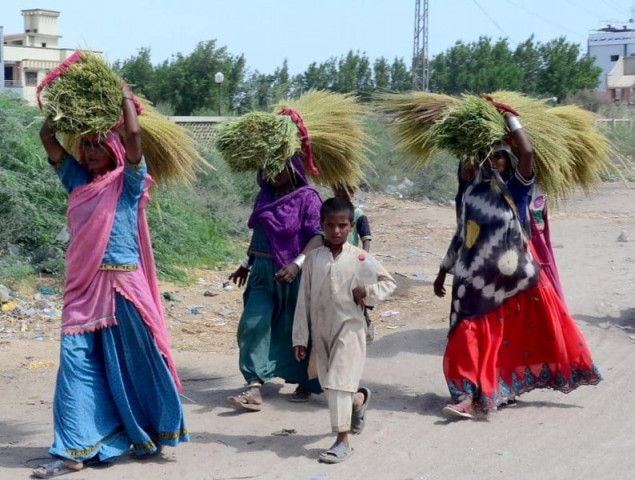Rural women in suburbs of Hyderabad. Photo: Express
ISLAMABAD:
The World Bank on Wednesday softened its position on the poverty reduction claim for Pakistan and said that only certain segments of the poor saw an improvement while other classes, particularly the rural poor, did not see any improvement in their living standards.
In a detailed note in response to contradictions pointed out in the two published reports by the media, the World Bank said that its simulation models of poverty numbers were only “useful (for) directional insights but do not carry the statistical precision”.
While explaining the position, the local office of the Washington-based lender said that early signs of economic recovery in the last fiscal year were estimated to have translated into some welfare improvements for certain segments of the poor, such as those working in construction and logistics.
“Other segments of the poor, such as the rural poor, have not seen an improvement in their living standards due to low agricultural growth,” said the bank in the note issued on Wednesday. It added that given the high degree of job informality in these sectors, especially for low-skill work, volatility in the growth of these sectors can sharply diminish real wages for the poor when there is a shock. A day earlier, the World Bank put the national poverty rate for the last fiscal year at 22.2%, which it did not change, but explained that the figure was not based on real and latest data.
The modest decline in the FY25 poverty rate should not be seen as a significant departure from previous trends but as an encouraging sign that economic stabilisation was mirrored in welfare improvements, it said.
“The 22.2% is a modest decrease from the FY24 estimate of 25.3%. The poverty projections are derived from the World Bank’s internal poverty projection methodology, which is based on a microsimulation model,” the lender elaborated.
Geographical inequalities also persist as another critical challenge, with rural areas remaining more than twice as poor as urban areas and startling provincial disparities in welfare, according to the World Bank. These challenges underscore the fragility of earlier progress and the urgent need for decisive policy action, it added.
The World Bank advised that “it is important to focus on broader, long-term trends – such as those outlined in the Pakistan Poverty, Equity, and Resilience Assessment – rather than year-on-year fluctuations”, as stated in the October 28 report. The Pakistan Poverty, Equity and Resilience Assessment stated that Pakistan’s current economic growth model was insufficient to improve the living standards of people.
“Modelled estimates provide useful directional insights but do not carry the statistical precision of survey-based figures,” it added.
The World Bank said that due to strong growth between fiscal year 2024 and 2025 in the construction and logistics sectors, which together employ about one quarter of the poor, some segments of the poor were able to benefit from higher labour incomes. Moreover, a sharp drop in food inflation in FY25 supported income increases by easing price pressures and improving the purchasing power for the poor.
“Pakistan has achieved macroeconomic stabilisation. We are estimating GDP growth at 3% for fiscal year 2025-26 and at that rate of economic growth, we project a slight reduction in the poverty rate,” said Tobias Haque, Lead Senior Economist at the World Bank.
However, a much faster rate of economic growth would be required to sustainably and significantly improve the living standards and change the country’s overall poverty trajectory, Haque said. The World Bank stated that Pakistan’s national poverty rates were based on the Household Integrated Economic Survey (HIES). Since there are large gaps between survey rounds, the World Bank used a projection methodology to estimate poverty in the interim period.
It added that Pakistan made notable strides in reducing poverty and boosting prosperity in the early 2000s, but progress has stalled since 2015 and poverty trends reversed in 2020. A series of shocks – including Covid-19, the 2022 floods and an economic downturn with record inflation – have reversed previous gains, with poverty reduction stagnating, according to the lender.
It underscored that Pakistan’s progress in human capital development has significantly lagged due to insufficient human capital investments and shortcomings in the accessibility and quality of public services, with nearly 40% of children suffering from stunting.
The lender said that the forthcoming Household Integrated Economic Survey would provide updated information regarding consumption distribution and key non-monetary indicators of poverty, and “will allow us to expand our analysis based on actual consumption data beyond 2018/19”.
While commenting on the recent slight upgrade in the economic growth rate, the World Bank said that its regional Economic Update included a projected 2.6% GDP growth rate for the current fiscal year. These estimates were clearly expressed as a ‘flood scenario’ based on ‘early estimates’ of flood impacts. The reports noted “significant uncertainty, with the full extent of the damage still to be determined”, it added. After economic projections for these publications had been finalised, additional data on flood impacts were shared with the World Bank by the government and the UN Food and Agriculture Organisation.
This data suggested smaller impacts on agricultural output than had been initially estimated.
[ad_1]
Images are for reference only.Images and contents gathered automatic from google or 3rd party sources.All rights on the images and contents are with their legal original owners.
[ad_2]

